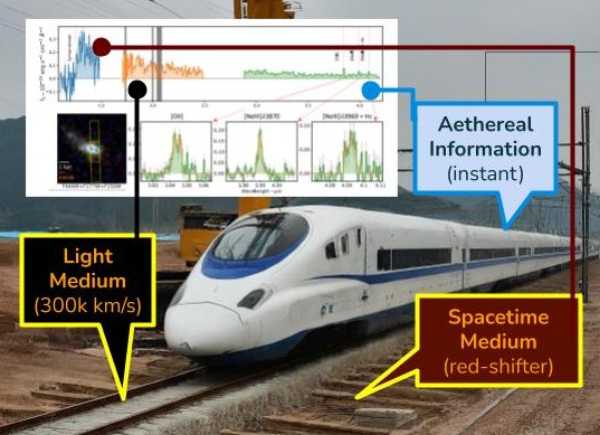How The James Webb Space Telescope (JWST) Debunks the Big Bang
The Big Bang is a consequence of Einstein’s sophistical General Relativity which imposes that the speed of light, and consequently information, travels at 300,000 kilometers per second.
Therefore, the light from an object 600,000 kilometers away is 2 seconds old, different from its current light.
This means that the light from very distant galaxies is billions of years old, closer to the age of the universe itself. That light would be from galaxies that are very young which means that they cannot possibly be fully developed.
Yet that’s exactly what James Webb Space Telescope (JWST) shows.

For example, JWST shows galaxy “Gz9p3” having the following properties:
- a Lyman break of 9.35. This shows that it is very far (and therefore very young to modern Physics)
- MUV of −21.66. This shows that it is very bright and massive (a quality of older galaxies)
To address this anomaly, researchers advise a revision of the star formation model (e.g. speed up star formation from the early universe), instead of the more common sense solution of throwing away both ΛCDM cosmology and General Relativity. Both CDM and Relativity are Einstein monstrosities that turn Nature upside down.
The Solution: Cartesian 5 Elements
The proper solution is Rene Descartes’ 5 Elements model. This model divides the labor between the 5 Elements:
- Aether
- Spacetime
- Light
- Weak
- Strong Force
These work together to create reality.
An analogy for the JWST findings is a bullet train on train tracks on ground.

- The ground represents spacetime
- The tracks are lightwaves that travel through spacetime
- The train is the information conveyed by those waves
- The speed of light is the rate of laying tracks.
- On good ground, the rate is 300 meters per work shift. On bad ground, it might be 100. On better ground, it might be 600.
Once the tracks have connected to both stations (star and telescope), then the bullet train travels instantly (or at least so much faster than the track-laying speed) between both ends.
In fact, Descartes extends this motion of the aether as it goes from the telescope into our eyes, brain, and lastly into the aethereal soul that experiences it.
This means that the distant galaxies that JWST observes are close to their current age instead of being billions of years old. This explains why they are already so massive and bright. (This also explains why entangled particles can teleport instantly.)
This is why Descartes insisted that the speed of light was instant. He really meant that it was the speed of the aether within light that was instant.
Matches the CMB as well
The findings of the JWST matches findings of the CMB in the sense that the CMB is really the fuzzy image of galaxies that are more distant than infrared.

This is why the CMB is uniform and matches the black body spectrum – because it shows the galaxies “behind” the edge of the universe arranged uniformly.
The CMB does not match the cosmic web because the cosmic web is for the visible observable galaxies, whereas the CMB is for unobservable galaxies.
It follows that the CMB is NOT the afterglow of the Big Bang which never exisited. Rather it is the fuzzy image of galaxies beyond the observable.